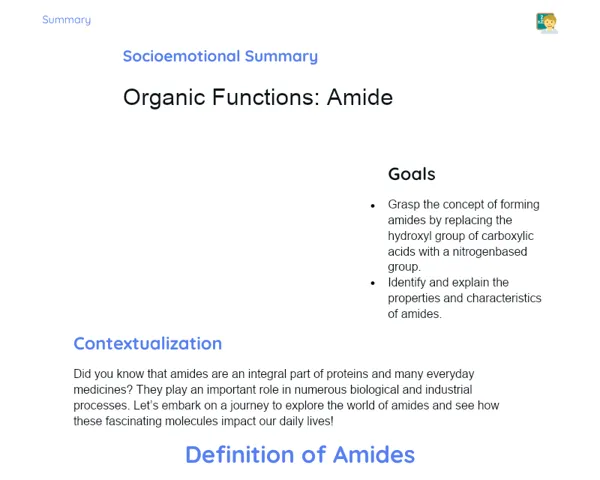Objectives
1. 🎯 Grasp the structure of amides and how they are formed through the reaction of carboxylic acids with amines.
2. 🎯 Recognize the properties and characteristics of amides, along with their significance in practical applications, including pharmaceuticals, textiles, and cosmetics.
Contextualization
Did you know that amides are a big part of our everyday life, often without us even noticing? Whether it's the nylon in our clothing, the flavor in our artificial sweeteners, or even the medications we rely on, amides are everywhere. These compounds not only exhibit intriguing chemical properties but are also integral to countless technological advancements and consumer goods. By deepening your understanding of amides, you're opening the door to a world of practical and scientific applications that touch our lives every day!
Important Topics
Molecular Structure of Amides
Amides are organic compounds featuring the functional group -CONH2. They result from the reaction of a carboxylic acid with an amine. The typical structure of an amide is RCONR'R'', where R, R', and R'' represent organic groups or hydrogen atoms. The peptide bond, which is fundamental to proteins, serves as an example of an amide. This structure bestows unique properties upon amides, such as solubility in organic solvents and the ability to form hydrogen bonds.
-
Formation: The process in which an amine reacts with a carboxylic acid results in the formation of an amide along with water, a reaction known as condensation.
-
Peptide Bond: This is the bond linking amino acids in proteins, essential to protein structure and function.
-
Solubility: Generally, amides dissolve well in organic solvents and are utilized as solvents in chemical synthesis.
Physical and Chemical Properties
Amides exhibit distinct physical and chemical properties that make them advantageous in diverse applications. They have higher melting and boiling points than esters and carboxylic acids with similar molecular weights due to strong intramolecular hydrogen bonds. Additionally, amides are less reactive than carboxylic acids, which enhances their stability.
-
Melting and Boiling Points: Amides have higher melting and boiling points owing to strong intramolecular hydrogen bonds, leading to a significant enthalpy of vaporization.
-
Stability: They are more stable under standard temperature and pressure conditions due to their lower reactivity compared to carboxylic acids.
-
Water Solubility: Low-molecular-weight amides can dissolve in water because they can form hydrogen bonds with water molecules.
Practical Applications of Amides
Amides find extensive use in the pharmaceutical sector for drug synthesis, in textiles for nylon production, and in cosmetics. They are ideal for these applications due to their capacity to form hydrogen bonds and their chemical stability. Moreover, amides are critical in the creation of polymers such as polyamides and polyurethanes, which are used in numerous industrial and consumer products.
-
Pharmaceutical Industry: Synthesis of drugs like penicillin, where the amide provides stability and biological activity.
-
Textile Industry: In the production of nylon, a polymer widely used in fabrics, carpets, and ropes.
-
Cosmetics: Utilized in creams and lotions for their moisturizing properties and chemical stability.
Key Terms
-
Amide: An organic compound with the functional group -CONH2, formed from the reaction of a carboxylic acid and an amine.
-
Peptide Bond: A specific type of amide that connects amino acids in proteins.
-
Condensation Reaction: A chemical reaction where two molecules combine, producing a water molecule.
For Reflection
-
How does the structure of amides relate to their physical and chemical properties, and why does this matter for practical uses?
-
In what ways can learning about amides spur innovations in industries like materials and healthcare?
-
What ethical and environmental issues arise from using amides in consumer products and industries?
Important Conclusions
-
We reviewed the formation of amides through the reaction of a carboxylic acid and an amine, discussing their molecular structure and unique physical and chemical properties.
-
We examined various practical applications of amides in sectors such as pharmaceuticals, textiles, and cosmetics, highlighting their vital roles in drug synthesis and polymer production.
-
We recognized the significance of amides in our lives, from the nylon in our clothing to the medicines we take, and how understanding these compounds can lead to technological and scientific progress.
To Exercise Knowledge
- Investigate and present a daily product that includes an amide, detailing its function and significance. 2. Plan an experiment to synthesize an amide in the lab and examine its properties. 3. Compose a brief opinion article discussing the environmental impacts of amide-based polymers and potential sustainable alternatives.
Challenge
Develop an engaging infographic illustrating the lifecycle of a product containing amide, from its creation to disposal, and suggest sustainable alternatives.
Study Tips
-
Utilize molecular modeling applications to visualize amide structures and enhance your understanding of their properties.
-
Watch videos demonstrating chemistry experiments that involve amide formation to bridge theoretical knowledge with practical applications.
-
Engage in online communities or study groups to delve deeper into the applications of amides in industry and scientific research.



